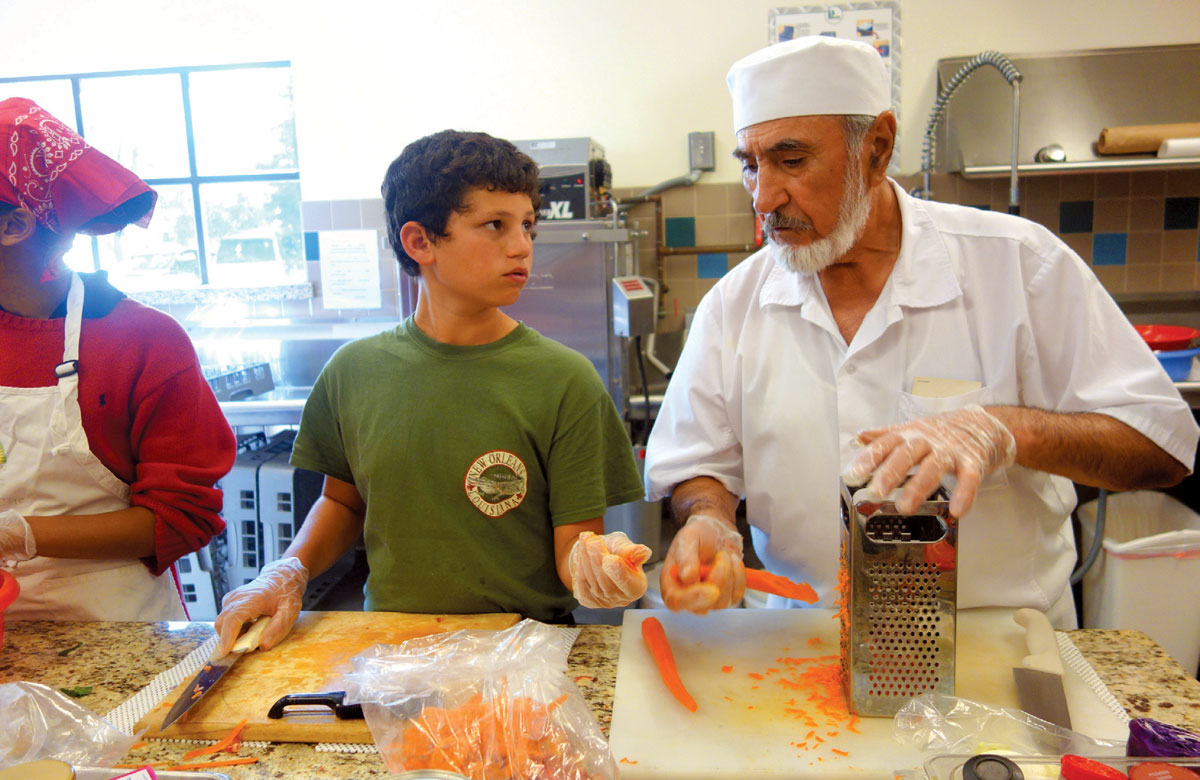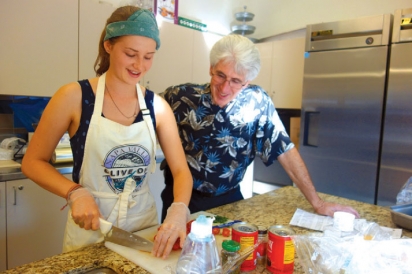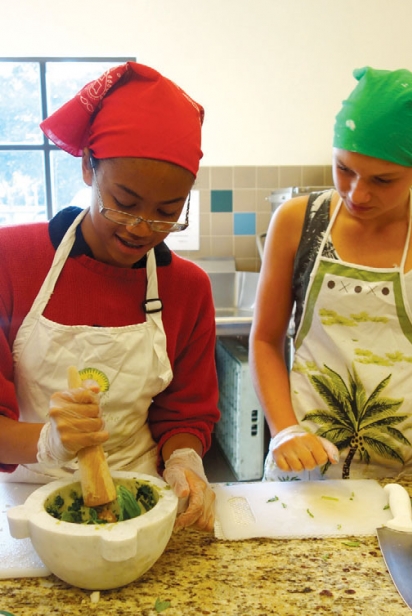Food of Love: Youth Program Nurtures Both Givers and Receivers
Walk into the St. Helena Grace Episcopal Church on most Tuesday afternoons and you’ll hear chopping, sizzling and the pounding of a pestle and mortar; the long and narrow commercial kitchen crowded with cooks, the tops of their heads adorned with bandanas in different colors. Bursts of fresh basil might waft through the air over the steady, sweet smell of sauteed onions.
The center island will likely be piled with ingredients, bunches of carrots and dinosaur kale lit up by the sunshine filtering in from the only window; the crew focused, like the pause before a dishwasher starts up again.
But spend a minute at the doorway and you’ll quickly notice that this isn’t a group of professional chefs: There’s no dirty banter, someone is standing in the corner eating an orange popsicle and everyone is just a little bit young.
These are the volunteers for Food of Love, a program that teaches culinary skills to teenagers while they make healthy, free meals for cancer patients.
Food of Love began in 2010 under the inspiration of Cindy Cantrell, nurse navigator of St. Helena Hospital’s Martin O’Neil Cancer Center; Amy Cohen of A and A Kitchen; and the Napa Valley Youth Advocacy Center.
The program is modeled after the Ceres Community Project, a larger-scale initiative in Sonoma and Marin counties that serves meals to cancer patients through youth volunteers and that is also profiled in this issue of Edible Marin & Wine Country.
Food of Love engages youth ages 12 to 19 who make meals for about 10 cancer patients who are being treated at the Martin O’Neil Cancer Center. The students get together once a week after school, make several dishes and deliver them to the Rianda House, where they’re picked up the next day. Meals are provided for free for three months and afterwards paid for on a donation basis. Altogether, the program has served hundreds of meals to people battling cancer.
But it’s not just about the meals. Food of Love supports three distinct populations, which is part of what makes the program dynamic: Young people gain culinary skills, learn about teamwork and experience the value of helping other people; adult volunteers serve as mentors; and patients get nutrient-rich food delivered to their doors, in addition to a community of folks who are volunteering, cooking and rooting for them.
A DIFFERENT EDUCATION
Tom Amato, executive director of the Napa Valley Youth Advocacy Center, has been an educator for four decades, teaching in grade school up to college level classrooms before launching the center. He air-draws his ideas for me while we’re at lunch, starting with our basic needs as humans—survival, love, belonging, freedom, fun, purpose, value and identity—and ending with his hands waving in the air describing the ways in which educational systems can stifle those needs or fulfill them.
He’s Sicilian and a child of the 1960s, which we both agree makes him fiercely passionate.
“School systems tell kids that one day when you grow up you’ll have purpose, identity and value if you just do what we tell you to do,” he said. “But I want kids to feel that they have purpose, identity and value, and that they can make a difference right now—just the way they are.”
Founded in 2004, the center opened as an after-school program serving Angwin, Deer Park and St. Helena. Their clients range across the spectrum, the focal point being on youth that are high risk and susceptible to drugs, alcohol, rebellion and lack of support from their family and community.
In 2012 there was a defining shift in programs into a new paradigm of youth support, expanding beyond the walls of the center and into community service. The center overlays group counseling and individual support with community service programs, a combination that Amato said allows students to develop meaningful relationships, life skills and emotional well-being while providing support to other often under-appreciated populations.
These programs include monthly dinners made by youth for combat veterans at the Pathway Home; a collaboration with the Rianda Senior House; and, of course, Food of Love.
KITCHEN SKILLS AND BEYOND
Before we entered the kitchen, Amato told me that most of the students volunteering for Food of Love that day are not among the most at-risk students at the center. Still, it’s uplifting to watch any group of teenagers—especially women—demonstrate confidence, teamwork and some serious cooking skills.
Food of Love begins around 3pm on Tuesdays. The students come in, greeted by Amato and volunteer chef Delio Cuneo, who together have done the grocery shopping and prepped each station with a recipe and ingredients. The recipes are simple comfort foods full of vegetables and leaning towards Italian and Californian cooking styles. There’s minestrone, polenta with mushrooms, a light coleslaw and chicken with Jerusalem artichokes.
The first thing I notice is that the students hold their knives properly, their thumbs resting on the blades, hands wrapped around the bolster of the knife. They’re more at ease chopping vegetables than most adults I know.
Claire Ebersole, 13, and Vola Andrianarijaona, 15, make the pesto with a mortar and pestle, checking in with each other on taste and adding more garlic or salt as needed. Andrianarijaona has glasses and braces, and her red sweatshirt matches her red bandana that covers so much of her head it makes her seem more petite. Ebersole looks a little older, maybe because she’s taller and has been volunteering with the center since she was 8. I note teasingly that they’re not cutting any corners and that a lot of people would use a food processor for pesto.
“Well, it wouldn’t taste the same,” said Ebersole matter-of-factly, making me wish I knew her better to justify my proud smile.
Electra Lyman, 16, barely refers to the recipe as she works the stove browning chicken thighs in batches. Both Lyman and her sister are the veterans; they’ve been coming here since the beginning of the program and they navigate the kitchen like it’s their own.
On the other side of the kitchen is Francis Aquilina, 13, the youngest in the room. He sticks to Cuneo’s side, who shows him how to dice potatoes and julienne carrots. Later he does it on his own, his baby face now intently focused on cutting the carrots into sections before cautiously slicing them lengthwise.
When the meals are completed they’re put into paper grocery bags labeled with names and Amato delivers them to the Rianda House or straight to the recipient’s home.
Cards with well wishes and inspirational messages written by the students accompany the meals. June Huang, a Chinese exchange student, sits in front of a pile of brightly colored cards with smiley faces and suns, struggling with what to write. Alexandra Abend is sitting next to her; she’s a high school senior but she’s gracious beyond her years. She pauses thoughtfully before she speaks and several times uses self-mockery to get a laugh from the two other young women sitting next to her. She said that teamwork is her biggest takeaway from Food of Love. Then she pauses, “and valuing what I have.” She turns to Huang and offers several prompts to help her start writing.
HOLISTIC HEALING
It strikes me that almost everyone I talk to volunteering that day, no matter their age, has a personal experience with cancer. It’s a reminder that cancer doesn’t exist in a vacuum and that many of the volunteers are doing their own healing, as well.
Chloe Hagen, also on card duty, has long straight blonde hair that’s swooped to the side and tucked behind her left ear. When she was 6 years old Hagen was diagnosed with cancer and at age 10 the left side of her brain was removed. Doctors predicted she wouldn’t be able to talk or walk afterwards, but she woke up asking for water. Today she can’t move her right arm, but is as active as any teenager, with a little help from a brace on her right leg.
“It feels good to give back. I know I would be thankful for these meals,” she said. She’s now in her freshman year of high school, and has been volunteering for the center since middle school.
“The kids realize that they have the ability to make a difference in other people’s lives, and that changes them instantly. They keep coming back because they need a fix of this joy that they’re experiencing,” said Amato.
It’s not just kids who come back each week. There are typically three adult volunteers in the kitchen: a head chef and two mentors. Cuneo, clearly the head chef in his stark white chef ’s coat and hat, speaks in a thick Italian accent from his native Genoa and a quiet, raspy voice. He goes from darting around the kitchen looking for a specific tool or spice to gently giving students instructions. Before coming in he spends a few hours putting together the recipes, writing them by hand on lined sheets of paper in slanted block capitals.
While shaving the skin off a particularly gnarly celery root, he tells me that he and his wife used to cook together. They owned two restaurants, one in San Francisco’s North Beach and another in St. Helena. About seven years ago she passed due to lung cancer. “She was gone in six months. She was only 61,” he said.
For Cuneo, bringing some relief to the patients’ families gives him comfort. “It’s not easy for anybody,” he said, shaking his head.
While cooking meals for his wife must have been second nature for Cuneo, a homemade meal stacked with nutrients isn’t always accessible to patients, especially those who don’t have caretakers. For starters, many patients don’t know how to cook healthy meals, or like many Americans are used to a diet based on processed foods. Plus, treatments can be debilitating, making it difficult to shop, cook or clean
To enroll in Food of Love, a patient’s healthcare team (their nurses, doctors or the clinical care navigator) refers them to the cancer center’s registered dietician, Laura Grinnell. Grinnell then assists the Food of Love team with recipe selection and modification based on the individual person’s needs.
“Our physicians and registered dietitian recommend this program because nutrition is so important while going through chemotherapy and radiation treatment,” said Shari Bluband, executive director of the cancer center.
Indeed, good nutrition during treatment has clear benefits: support for the immune system, reducing side effects, improving energy levels and maintaining weight. The meals are designed to contain specific ingredients that provide the vitamins, minerals and natural plant compounds (phytonutrients) to enhance a patient’s wellness.
David Kernberger lost his wife to cancer six years ago and has been in the program since he was diagnosed with prostate cancer.
“I’m not a cook and live alone, so the program is a wonderful way to get a variety of food that I would never dream of having. The rest of the week I’m eating really ordinary food that I can grab at the market,” he said. “It really adds a sparkle into my eating and the cards are wonderful, too.”
After undergoing two radiation treatments, Kernberger says he’s cautiously on his way to recovery.
In an effort to help patients continue with good nutrition habits even after treatment, the cancer center also offers a monthly nutrition class with cooking demonstrations, available to patients and their families at no cost.
These days, Bluband says it’s not uncommon to find programs linking nutritional support to cancer patients. But Food of Love is unique for its dual mission: Whether cooking or eating, the program provides purpose and healing to youth and adults at an important time in their lives. How much sweeter the food must taste, when cooked with compassion and hope.
The day after I shadowed the volunteers, Amato sent me a letter he had received from a patient, Iris. Here are a few excerpts:
Your Wednesday surprises are the highlight of our week and we feel so fortunate to be benefitting from your program! It is amazing how the love and thoughtfulness, in terms of healthy food to combat cancer, gets translated into deliciously complex and tasty meals.
The picture of all of you—however many in the kitchen, talking, laughing, tasting and learning with the knowledge that you are making food to help a lot of people you don’t even know almost makes me envious.
She signs with the words I doubt most teenagers hear on Tuesday afternoons: “Take care of yourself, I love you, and I thank you from the bottom of my heart.”







